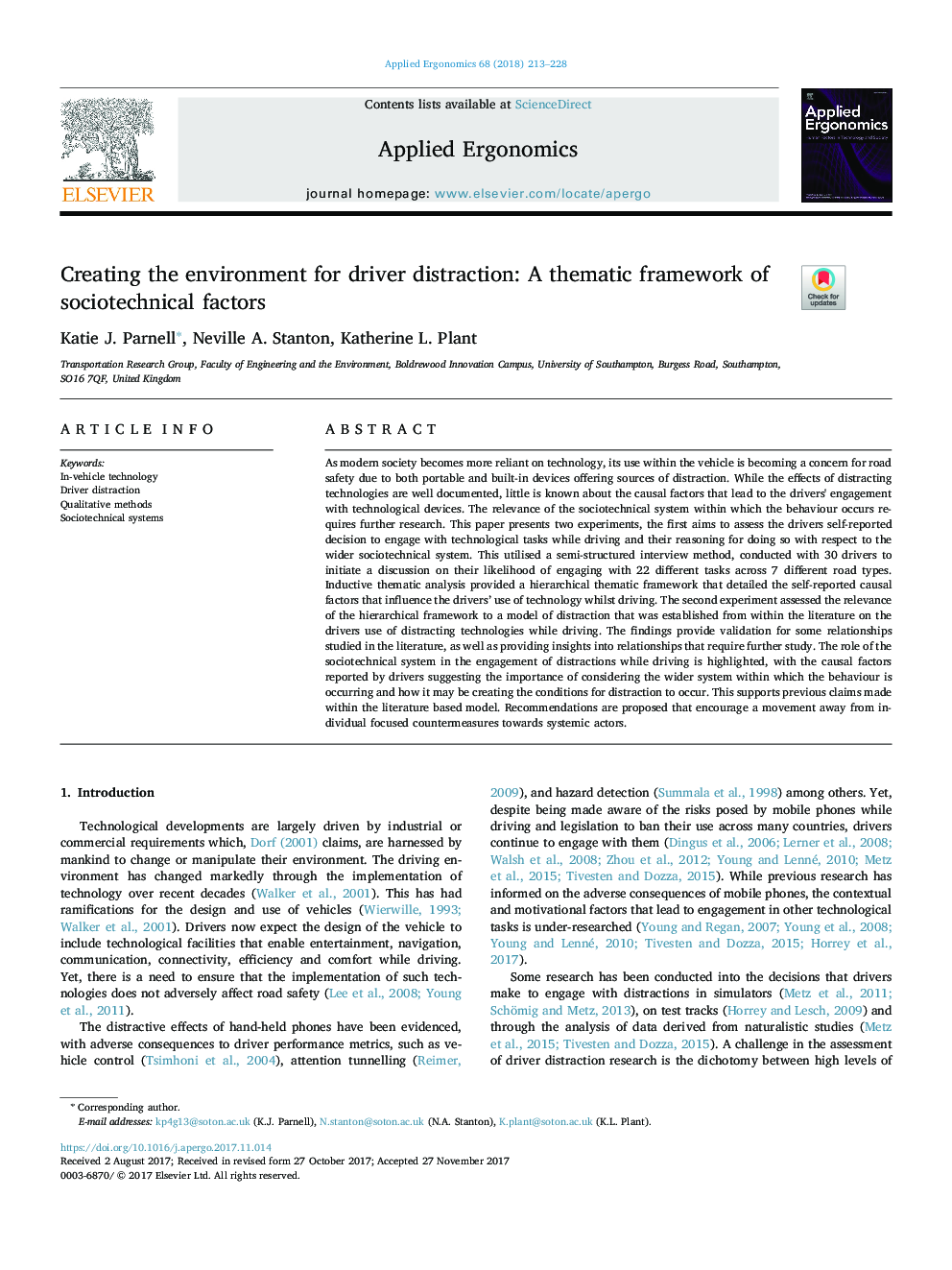| کد مقاله | کد نشریه | سال انتشار | مقاله انگلیسی | نسخه تمام متن |
|---|---|---|---|---|
| 6947691 | 1450702 | 2018 | 16 صفحه PDF | دانلود رایگان |
عنوان انگلیسی مقاله ISI
Creating the environment for driver distraction: A thematic framework of sociotechnical factors
ترجمه فارسی عنوان
ایجاد محیط برای رد حریق: یک چارچوب موضوعی از عوامل اجتماعی-تکنیکی
دانلود مقاله + سفارش ترجمه
دانلود مقاله ISI انگلیسی
رایگان برای ایرانیان
کلمات کلیدی
تکنولوژی درون خودرو، منحرف کننده راننده، روش های کیفی، سیستم های اجتماعی
ترجمه چکیده
همانطور که جامعه مدرن بیشتر به فن آوری وابسته است، استفاده از آن در خودرو، به دلیل وسایل نقلیه قابل حمل و ساخته شده در آن، منجر به حواس پرتی می شود. در حالی که اثرات تکنولوژی های حواس پرت شده به خوبی مستند شده است، در مورد عوامل علمی که منجر به تعامل رانندگان با دستگاه های تکنولوژیکی می شود، کم است. ارتباط سیستم های اجتماعی که در آن رفتار به وجود می آید نیازمند تحقیقات بیشتری است. این مقاله دو آزمایش را ارائه می دهد، نخستین هدف این است که تصمیم گیرندگان خود تصمیم گیرنده برای درگیر شدن با وظایف تکنولوژیکی در هنگام رانندگی و استدلال خود برای انجام این کار با توجه به نظام اجتماعی گسترده تر، ارزیابی کنند. این روش مصاحبه نیمه ساختار یافته را با استفاده از 30 راننده برای بحث در مورد احتمال خود درگیر شدن با 22 کار مختلف در 7 نوع مختلف جاده مورد استفاده قرار داد. تجزیه و تحلیل تئوری تحلیلی ارائه یک چارچوب موضوعی سلسله مراتبی است که عوامل فاکتور علت خود را گزارش می دهند که بر ریسک استفاده از تکنولوژی در هنگام رانندگی تأثیر می گذارد. آزمایش دوم، ارتباط چارچوب سلسله مراتبی را با یک مدل حواس پرتی که از درون ادبیات در مورد استفاده از فن آوری های منحرف شده در هنگام رانندگی ایجاد شده بود، مورد بررسی قرار داد. یافته ها اعتبارسنجی برخی از روابط مورد مطالعه در ادبیات را ارائه می دهند و همچنین ارائه بینش نسبت به روابطی که نیاز به مطالعه بیشتر دارند. نقش سیستم اجتماعی تکنولوژیک در تعامل با حواس پرتی در حین رانندگی، با عوامل موثر بر راننده نشان می دهد که اهمیت بررسی سیستم گسترده ای که در آن رفتار اتفاق می افتد و چگونگی ایجاد شرایطی برای حواس پرتی می شود، مشخص می شود. این ادعاهای قبلی را در قالب مدل ادبیات ارائه می دهد. پیشنهادات پیشنهاد شده است که جنبش را از اقدامات متمرکز فردی به سوی بازیگران سیستمیک تشویق می کند.
موضوعات مرتبط
مهندسی و علوم پایه
مهندسی کامپیوتر
تعامل انسان و کامپیوتر
چکیده انگلیسی
As modern society becomes more reliant on technology, its use within the vehicle is becoming a concern for road safety due to both portable and built-in devices offering sources of distraction. While the effects of distracting technologies are well documented, little is known about the causal factors that lead to the drivers' engagement with technological devices. The relevance of the sociotechnical system within which the behaviour occurs requires further research. This paper presents two experiments, the first aims to assess the drivers self-reported decision to engage with technological tasks while driving and their reasoning for doing so with respect to the wider sociotechnical system. This utilised a semi-structured interview method, conducted with 30 drivers to initiate a discussion on their likelihood of engaging with 22 different tasks across 7 different road types. Inductive thematic analysis provided a hierarchical thematic framework that detailed the self-reported causal factors that influence the drivers' use of technology whilst driving. The second experiment assessed the relevance of the hierarchical framework to a model of distraction that was established from within the literature on the drivers use of distracting technologies while driving. The findings provide validation for some relationships studied in the literature, as well as providing insights into relationships that require further study. The role of the sociotechnical system in the engagement of distractions while driving is highlighted, with the causal factors reported by drivers suggesting the importance of considering the wider system within which the behaviour is occurring and how it may be creating the conditions for distraction to occur. This supports previous claims made within the literature based model. Recommendations are proposed that encourage a movement away from individual focused countermeasures towards systemic actors.
ناشر
Database: Elsevier - ScienceDirect (ساینس دایرکت)
Journal: Applied Ergonomics - Volume 68, April 2018, Pages 213-228
Journal: Applied Ergonomics - Volume 68, April 2018, Pages 213-228
نویسندگان
Katie J. Parnell, Neville A. Stanton, Katherine L. Plant,
